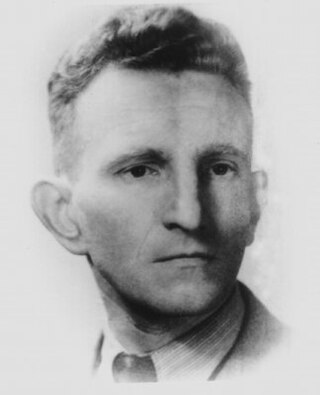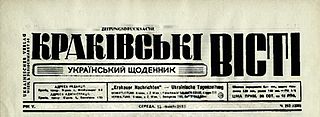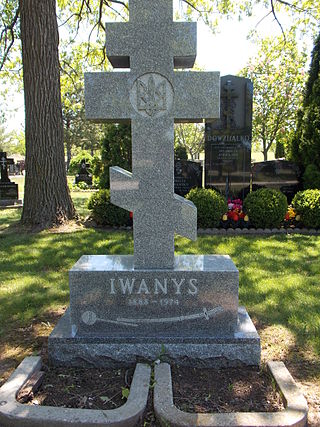Existing

Draža Mihailović statue, Hamilton
There is a statue in Hamilton, Ontario of Draža Mihailović, a Yugoslav Serb general during World War II. He was the leader of the Chetniks, a royalist and Serbian nationalist movement and guerrilla force, who collaborated with the Nazis following the German invasion of Yugoslavia in 1941. [1]
Ukrainian
Monuments in Canada to members of the Ukrainian Waffen-SS have been vandalized by activists at differing times as "Nazi monuments", as have monuments to members of the Ukrainian Insurgent Army. Leaders of the Canadian Ukrainian community said the Ukrainian monuments are not related to Nazism. [2]
Roman Shukhevych statue, Edmonton

The bronze bust [3] of Ukrainian nationalist leader Roman Shukhevych, who collaborated with the Nazis from February 1941 to December 1942 as commanding officer of the Nachtigall Battalion in early 1941, [4] and as a Hauptmann of the German Schutzmannschaft 201 auxiliary police battalion in late 1941 and 1942, [5] units which were complicit in the Galicia-Volhynia massacres of ethnic Poles and in the Lviv pogroms (1941) against Jews. The bust was built in 1972 by Ukrainian World War II veterans on private land near the Ukrainian Youth Unity Complex in Edmonton, Alberta. [6] [7] [8] [9] The statue was vandalised in 2019 when someone added the words "Nazi scum". [10] It was vandalised again in 2021 when someone added the words "Actual Nazi" in red paint. [7]
Memorial at St. Michael’s Cemetery, Edmonton

A memorial reading For those who fought for Ukraine’s Freedom was constructed in St. Michael’s Cemetery in Edmonton in 1976 by former members of the Ukrainian Waffen-SS division: 14th Waffen Grenadier Division of the SS (1st Galician). [11]
The International Military Tribunal's verdict at the Nuremberg Trials declared the entire Waffen-SS a "criminal organization" guilty of war crimes [12] but the Canadian Deschênes Commission of October 1986 concluded this Ukrainian division should not be indicted as a group. [13]
In 2021 the memorial was vandalized by painting "Nazi monument to 14th Waffen SS". [14] A spokesperson for the Canadian Friends of Simon Wiesenthal Center said “These monuments are nothing less than a glorification and celebration of those who actively participated in Holocaust crimes as well the mass murder of Polish civilians." [15] Jewish organizations requested the removal of the damaged memorial. [14] However, the Ukrainian Catholic Church called the vandalism "part of the decades-long Russian disinformation campaign against Ukraine and Ukrainians to create a false Nazi image of Ukrainian freedom fighters." [15] The St. Michael’s monument is dedicated to "Fighters for the Freedom of Ukraine". One of its plaques is an abbreviation for the First Division Division of the Ukrainian National Army. [16] [17] On April 25, 1945, the Waffen-SS Galizien was officially reorganized as the First Division of the Ukrainian National Army, and swore a new oath of loyalty to the Ukrainian people. [18] Bernie Farber of the Canadian Jewish Congress wrote that "removing this monument will require the Ukrainian-Canadian community to take a hard look at its own history." [19] University of Alberta historian Jars Balan told CBC News that the history of the monument and the Shukhevych statue were "complicated", saying that some people had fought in German uniforms in order to achieve Ukrainian independence. [14]
Memorial at St. Volodymyr Ukrainian Cemetery, Oakville
A granite memorial entitled Pamiatnyk Slavy UPA (English: Monument to the Glory of the UPA) celebrating the Ukrainian Insurgent Army, a Ukrainian nationalist force that allied with the Nazis in 1942-43 before fighting against them in 1943-44, was inaugurated on May 26, 1988, in the St. Volodymyr Ukrainian Cemetery in Oakville, Ontario. [20] A cenotaph to veterans of the 14th Waffen Grenadier Division of the SS (1st Galician) was added shortly afterwards, with the SS division's insignia. [20]
The SS cenotaph was vandalised in mid-June 2020 when someone added the words "Nazi war monument". [21] [22] Canadian police apologized for originally stating that the vandalism was motivated by hate. [23] [24]
Both monuments were the subject of complaints from the Russian Embassy to Canada in 2017. [25] Ihor Michalchyshyn, the CEO of the Ukrainian Canadian Congress accused Russia of obfuscation. [26]
Jewish B’nai Brith organization and the Canadian Polish Congress called for the SS monument's removal in a joint statement, saying that the presence of monuments that whitewash the Holocaust and Nazi ideology is unacceptable in Canada. [27] [28] Oakville Mayor Rob Burton stated that he would remove the SS monument but he can’t, because municipalities have no right to regulate private cemeteries. [29]
Streets and Parks named after Alexis Carrel
In 2015 CTV News reported that in Quebec a street in Gatineau was named after Alexis Carrel, as well a street and park named after him in 1972 and 1988 respectively in Montreal community Rivière des Prairies, and a park and streets named after him in Boisbriand and Châteauguay. [30] Carrel won the Nobel Prize in Medicine in 1912, and was a supporter of eugenics and the Nazis, advocating for the elimination of "undesirables", and was involved in the Vichy government of France. [31] [32] [33] In 2015 the street in Gatineau was renamed after Marie Curie. [33] In 2017 it was announced that the street and the park in Rivière des Prairies, Montreal would be renamed. This followed a campaign from the Centre for Israel and Jewish Affairs of Quebec, who said that they hoped Boisbriand and Châteauguay would follow the lead of Montreal and Gatineau. [34]















